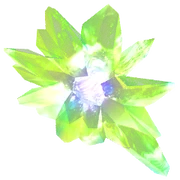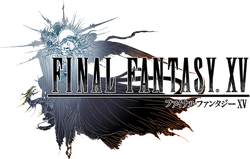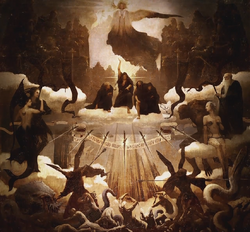Intangir Bot (talk | contribs) m (Bot: Automated text replacement (-Type (series) +Type series)) Tag: apiedit |
|||
| (20 intermediate revisions by 4 users not shown) | |||
| Line 1: | Line 1: | ||
| ⚫ | |||
{{DISPLAYTITLE:''Fabula Nova Crystallis: Final Fantasy''/Recurring elements}} |
{{DISPLAYTITLE:''Fabula Nova Crystallis: Final Fantasy''/Recurring elements}} |
||
The following is a list of '''recurring elements''' in the ''[[Fabula Nova Crystallis: Final Fantasy]]'' subseries. As the games in ''Fabula Nova Crystallis: Final Fantasy'' series share a common mythos, they have common concepts albeit used with varying interpretations. |
The following is a list of '''recurring elements''' in the ''[[Fabula Nova Crystallis: Final Fantasy]]'' subseries. As the games in ''Fabula Nova Crystallis: Final Fantasy'' series share a common mythos, they have common concepts albeit used with varying interpretations. |
||
| Line 7: | Line 8: | ||
[[Crystal (term)|Crystals]] represent [[Soul (Fabula Nova Crystallis)|souls]], [[Divinity in Final Fantasy|divinity]], and the origin of [[Magic (term)|magic]]. This hearkens back to the main [[Final Fantasy series|''Final Fantasy'' series]] where crystals have been a staple since the series's inception, but ''Fabula Nova Crystallis''—as the name suggests—aims for new interpretations of the role of crystals in the series. |
[[Crystal (term)|Crystals]] represent [[Soul (Fabula Nova Crystallis)|souls]], [[Divinity in Final Fantasy|divinity]], and the origin of [[Magic (term)|magic]]. This hearkens back to the main [[Final Fantasy series|''Final Fantasy'' series]] where crystals have been a staple since the series's inception, but ''Fabula Nova Crystallis''—as the name suggests—aims for new interpretations of the role of crystals in the series. |
||
| − | Divine tasks given to humans via the intermediary of the crystal is an overarching concept in the series. In ''[[Final Fantasy XIII]]'' and [[Lightning Saga|its sequels]], and the [[Type series|''Type'' series]], these manifest as [[Focus (Fabula Nova Crystallis)|Foci]], tasks given to [[l'Cie]] either by the [[fal'Cie]] (in ''Final Fantasy XIII'') or a [[Crystal (Type series)|Crystal]] (''[[Final Fantasy Type-0]]''), but the effects on the l'Cie differ between these worlds. Also in ''Final Fantasy Type-0'' [[Arecia Al-Rashia]], a divine servant, has chosen the cadets of [[Class Zero]] to carry out a task, namely, to become [[Agito (term)|Agito]]. In ''[[Lightning Returns: Final Fantasy XIII]]'' [[Lightning (Final Fantasy XIII)|Lightning]]'s role is also similar, having been given the divine role of the [[savior]] by the god [[Bhunivelze (character)|Bhunivelze]]. In ''[[Final Fantasy XV]]'', a key part of the story is the Crystal choosing the main protagonist [[Noctis Lucis Caelum]] to become the world's savior, the "[[True King]]". |
+ | Divine tasks given to humans via the intermediary of the crystal is an overarching concept in the series. In ''[[Final Fantasy XIII]]'' and [[Lightning Saga|its sequels]], and the [[Type series|''Type'' series]], these manifest as [[Focus (Fabula Nova Crystallis)|Foci]], tasks given to [[l'Cie]] either by the [[fal'Cie]] (in ''Final Fantasy XIII'') or a [[Crystal (Type series)|Crystal]] (''[[Final Fantasy Type-0]]''), but the effects on the l'Cie differ between these worlds. Also in ''Final Fantasy Type-0'' [[Arecia Al-Rashia]], a divine servant, has chosen the cadets of [[Class Zero]] to carry out a task, namely, to become [[Agito (term)|Agito]]. In ''[[Lightning Returns: Final Fantasy XIII]]'' [[Lightning (Final Fantasy XIII)|Lightning]]'s role is also similar, having been given the divine role of the [[Savior (Lightning Returns)|savior]] by the god [[Bhunivelze (character)|Bhunivelze]]. In ''[[Final Fantasy XV]]'', a key part of the story is the Crystal choosing the main protagonist [[Noctis Lucis Caelum]] to become the world's savior, the "[[True King]]". |
Crystals have a will of their own that drives life, and by their acts a desired destiny can be meted out. Deviation of this will transforms a l'Cie into a [[Cie'th]]—a monster—as punishment. In ''Final Fantasy XIII'' the fal'Cie want to forge the tools to strike down [[Cocoon (Final Fantasy XIII)|Cocoon]] with further downstream effects that manifest as time [[paradox]]es and the end of time and broken cycle of life. Try as they might to escape their fate, Lightning and her friends inadvertently act out the destiny that was designed. |
Crystals have a will of their own that drives life, and by their acts a desired destiny can be meted out. Deviation of this will transforms a l'Cie into a [[Cie'th]]—a monster—as punishment. In ''Final Fantasy XIII'' the fal'Cie want to forge the tools to strike down [[Cocoon (Final Fantasy XIII)|Cocoon]] with further downstream effects that manifest as time [[paradox]]es and the end of time and broken cycle of life. Try as they might to escape their fate, Lightning and her friends inadvertently act out the destiny that was designed. |
||
| Line 20: | Line 21: | ||
L'Cie and fal'Cie, as well as Cie'th, wield magic, and it is implied this power is granted by the crystal. In ''Final Fantasy XIII'' l'Cie "channel" their spells from their eidolith. A l'Cie can forge a pact with an [[Eidolon (Final Fantasy XIII)|Eidolon]], messengers of the goddess Etro, and summon them to the mortal realm via their eidolith. [[Serah Farron]] relinquishes a "crystal tear" to her fiancé [[Snow Villiers]], and it is implied to act as an extension of her being, allowing her to see and hear those near the crystal tear even if her physical body is elsewhere. |
L'Cie and fal'Cie, as well as Cie'th, wield magic, and it is implied this power is granted by the crystal. In ''Final Fantasy XIII'' l'Cie "channel" their spells from their eidolith. A l'Cie can forge a pact with an [[Eidolon (Final Fantasy XIII)|Eidolon]], messengers of the goddess Etro, and summon them to the mortal realm via their eidolith. [[Serah Farron]] relinquishes a "crystal tear" to her fiancé [[Snow Villiers]], and it is implied to act as an extension of her being, allowing her to see and hear those near the crystal tear even if her physical body is elsewhere. |
||
| + | [[File:FFT-0 Suzaku Crystal Glowing.png|thumb|[[Vermilion Bird Crystal]] in ''Final Fantasy Type-0''.]] |
||
In ''Final Fantasy Type-0'' the Crystals take a more traditional role as in early main series ''Final Fantasy'' games as entities that govern great magical power granted to the kingdoms of the world. The Crystals of Orience are sentient and make humans l'Cie to exert their Will in the world, even if Pulse and Lindzei also exist in the mythos, but one's soul can again be bound on the mortal realm via crystallization of the body. The [[Eidolon (Type-0)|Eidolons]] have a different form in ''Final Fantasy Type-0'' than in ''Final Fantasy XIII'', not being mechanical beings, but they are again implied to be of divine origin. |
In ''Final Fantasy Type-0'' the Crystals take a more traditional role as in early main series ''Final Fantasy'' games as entities that govern great magical power granted to the kingdoms of the world. The Crystals of Orience are sentient and make humans l'Cie to exert their Will in the world, even if Pulse and Lindzei also exist in the mythos, but one's soul can again be bound on the mortal realm via crystallization of the body. The [[Eidolon (Type-0)|Eidolons]] have a different form in ''Final Fantasy Type-0'' than in ''Final Fantasy XIII'', not being mechanical beings, but they are again implied to be of divine origin. |
||
| Line 28: | Line 30: | ||
Humans in the ''Fabula Nova Crystallis'' mythos are unique creatures without parallel: they were created from material in the physical world (the blood of Etro), but hold the energy of the [[unseen realm]] (the [[Chaos (Final Fantasy XIII)|chaos]] forming their [[Heart (Fabula Nova Crystallis)|hearts]]) inside them, giving them emotions and an independent self. This allows them to exist in both the physical and the ethereal. Other creatures, such as the world's deities and fal'Cie, are tied to the physical realm, and Etro was tied to the unseen realm after her death. The power humans hold is generally exploited by the fal'Cie by branding select humans as l'Cie. |
Humans in the ''Fabula Nova Crystallis'' mythos are unique creatures without parallel: they were created from material in the physical world (the blood of Etro), but hold the energy of the [[unseen realm]] (the [[Chaos (Final Fantasy XIII)|chaos]] forming their [[Heart (Fabula Nova Crystallis)|hearts]]) inside them, giving them emotions and an independent self. This allows them to exist in both the physical and the ethereal. Other creatures, such as the world's deities and fal'Cie, are tied to the physical realm, and Etro was tied to the unseen realm after her death. The power humans hold is generally exploited by the fal'Cie by branding select humans as l'Cie. |
||
| − | The concept of l'Cie alludes to the [[Warriors of Light]], a recurring theme in the ''Final Fantasy'' series where a group of warriors brought together by circumstance become "branded" the Warriors of Light by the crystal, giving them a mission to save the world and often special powers to achieve said mission. This is part of a larger concept of ''Fabula Nova Crystallis: Final Fantasy'' in re-imagining core concepts of the series. In previous games becoming a Warrior of Light was depicted as heroic, whereas the ''Fabula Nova Crystallis'' series explores the concept of servitude to the crystal in a more sinister light, bringing the free will of chosen "warriors" into question. |
+ | The concept of l'Cie alludes to the [[Warriors of Light]], a recurring theme in the ''Final Fantasy'' series where a group of warriors brought together by circumstance become "branded" the Warriors of Light by the crystal, giving them a mission to save the world and often special powers to achieve said mission. This is part of a larger concept of ''Fabula Nova Crystallis: Final Fantasy'' in re-imagining core concepts of the series. In previous games becoming a Warrior of Light was depicted as heroic, whereas the ''Fabula Nova Crystallis'' series explores the concept of servitude to the crystal in a more sinister light, bringing the free will of chosen "warriors" into question. ''Final Fantasy XV'' and its downloadable content likewise share the theme of questioning the free will of the "Warriors of Light"; ranging from Noctis' role as the True King, to the burden of the [[Kingsglaive]] and the fall of [[Ardyn Izunia]]. In all cases, the will of the world's deities and its Crystal appear in contrast with human wishes despite being for their ultimate benefit. |
Human souls and their journey to the gate to the afterlife, known as [[Etro's gate]], plays a role in all of the ''Fabula Nova Crystallis'' games, as do the recurring deities Pulse, Lindzei and Etro. This alludes to the original mythos where the creator god [[Bhunivelze (character)|Bhunivelze]] wishes to find a way to enter the realm of the dead without needing to die himself, and creates the three lesser deities to help with the task. In ''Final Fantasy XIII'' and ''Type'' series, the deities have tasked their followers to find the gate in varying ways, but the humans of the world are largely ignorant of the concept of the afterlife. |
Human souls and their journey to the gate to the afterlife, known as [[Etro's gate]], plays a role in all of the ''Fabula Nova Crystallis'' games, as do the recurring deities Pulse, Lindzei and Etro. This alludes to the original mythos where the creator god [[Bhunivelze (character)|Bhunivelze]] wishes to find a way to enter the realm of the dead without needing to die himself, and creates the three lesser deities to help with the task. In ''Final Fantasy XIII'' and ''Type'' series, the deities have tasked their followers to find the gate in varying ways, but the humans of the world are largely ignorant of the concept of the afterlife. |
||
| Line 34: | Line 36: | ||
== Individual games == |
== Individual games == |
||
=== ''[[Final Fantasy XIII]]'' === |
=== ''[[Final Fantasy XIII]]'' === |
||
| ⚫ | |||
* [[Orphan]] indirectly refers to the series title with the line, "From shattered shards, a new crystal legend will arise". |
* [[Orphan]] indirectly refers to the series title with the line, "From shattered shards, a new crystal legend will arise". |
||
| − | * The thirteenth [[Datalog/Analects|Analect]] is called "Fabula Nova Crystallis". The analects themselves reprise the story from the official mythology adapted for the world of ''Final Fantasy XIII'', and thus include the creation of Cocoon. [[Ark (Final Fantasy XIII)|Arks]] are armories created by Pulse fal'Cie, for "a battle in the beyond", referring to the battle Bhunivelze plans to wage against [[Mwynn]] after the Door of Souls is found. |
+ | * The thirteenth [[Datalog (Final Fantasy XIII)/Analects|Analect]] is called "Fabula Nova Crystallis". The analects themselves reprise the story from the official mythology adapted for the world of ''Final Fantasy XIII'', and thus include the creation of Cocoon. [[Ark (Final Fantasy XIII)|Arks]] are armories created by Pulse fal'Cie, for "a battle in the beyond", referring to the battle Bhunivelze plans to wage against [[Mwynn]] after the Door of Souls is found. |
* There is a piece of music on the fourth disc of the ''[[Final Fantasy XIII: Original Soundtrack]]'' called "Fabula Nova Crystallis". |
* There is a piece of music on the fourth disc of the ''[[Final Fantasy XIII: Original Soundtrack]]'' called "Fabula Nova Crystallis". |
||
=== ''[[Final Fantasy XIII-2]]'' === |
=== ''[[Final Fantasy XIII-2]]'' === |
||
| − | {{sideicon|XIII2}} |
||
* The [[fragment]]s Etro's Sorrow, Pulse's Resolution, Lindzei's Desire, Mwynn's Tenderness and Bhunivelze's Sleep allude to the official mythos where Etro suffered abandonment, Pulse was determined to find the gate to the afterlife, Lindzei wanted to protect the world, Mwynn was kind and compassionate, and Bhunivelze fell into a deep crystal sleep to be awaken when the Door of Souls would be found. |
* The [[fragment]]s Etro's Sorrow, Pulse's Resolution, Lindzei's Desire, Mwynn's Tenderness and Bhunivelze's Sleep allude to the official mythos where Etro suffered abandonment, Pulse was determined to find the gate to the afterlife, Lindzei wanted to protect the world, Mwynn was kind and compassionate, and Bhunivelze fell into a deep crystal sleep to be awaken when the Door of Souls would be found. |
||
* Chaos, the malevolent substance that is also the building block for human hearts, was not mentioned in ''Final Fantasy XIII'', but plays a crucial role in ''Final Fantasy XIII-2''. The idea alludes to the official mythos where chaos is the substance threatening world balance. |
* Chaos, the malevolent substance that is also the building block for human hearts, was not mentioned in ''Final Fantasy XIII'', but plays a crucial role in ''Final Fantasy XIII-2''. The idea alludes to the official mythos where chaos is the substance threatening world balance. |
||
| Line 48: | Line 48: | ||
=== ''[[Lightning Returns: Final Fantasy XIII]]'' === |
=== ''[[Lightning Returns: Final Fantasy XIII]]'' === |
||
| − | {{sideicon|LR}} |
||
* The original mythos is reprised in the form of murals in the [[Temple Ruins]]. It focuses on Bhunivelze and his view on death as an impurity that ought not to exist. Bhunivelze himself hails from the official ''Fabula Nova Crystallis: Final Fantasy'' mythos. His turning into a crystal in the end alludes to the official mythos where Bhunivelze fell into a deep crystal sleep until he would be ready to challenge Mwynn in the unseen realm. Like in the official mythos, Bhunivelze desires to be the all-powerful ruler of the universe. |
* The original mythos is reprised in the form of murals in the [[Temple Ruins]]. It focuses on Bhunivelze and his view on death as an impurity that ought not to exist. Bhunivelze himself hails from the official ''Fabula Nova Crystallis: Final Fantasy'' mythos. His turning into a crystal in the end alludes to the official mythos where Bhunivelze fell into a deep crystal sleep until he would be ready to challenge Mwynn in the unseen realm. Like in the official mythos, Bhunivelze desires to be the all-powerful ruler of the universe. |
||
* Bhunivelze wanting to make Lightning the new goddess of death to facilitate the cycle of life may allude to Mwynn giving Etro a similar task in the official mythos. |
* Bhunivelze wanting to make Lightning the new goddess of death to facilitate the cycle of life may allude to Mwynn giving Etro a similar task in the official mythos. |
||
| Line 55: | Line 54: | ||
=== ''[[Final Fantasy Type-0]]'' === |
=== ''[[Final Fantasy Type-0]]'' === |
||
| − | {{sideicon|Type0}} |
||
| − | {{sideicon|Agito}} |
||
[[File:Altocrystarium-Type-0.jpg|thumb|Altocrystarium.]] |
[[File:Altocrystarium-Type-0.jpg|thumb|Altocrystarium.]] |
||
| − | * All deities, except for Bhunivelze, have an [[ |
+ | * All deities, except for Bhunivelze, have an [[Final Fantasy Type-0 accessories|accessory]] named after them. Pulse, Lindzei and Etro appear as part of the game's lore, although they are barely mentioned. |
* When Class Zero is heading to the top of [[Pandæmonium]], Cid mentions that mankind was born from Etro's blood, alluding to the original mythos. |
* When Class Zero is heading to the top of [[Pandæmonium]], Cid mentions that mankind was born from Etro's blood, alluding to the original mythos. |
||
* There are numerous references to Etro's gate: |
* There are numerous references to Etro's gate: |
||
| Line 71: | Line 68: | ||
** The design of [[the Rursan Arbiter]] sports many eye-like structures upon it. |
** The design of [[the Rursan Arbiter]] sports many eye-like structures upon it. |
||
* The peace treaty proposed during the cadets' [[Missions (Type-0)/Operation MA Demolition|Operation MA Demolition]] is called the "[[Fabula Pact]]." |
* The peace treaty proposed during the cadets' [[Missions (Type-0)/Operation MA Demolition|Operation MA Demolition]] is called the "[[Fabula Pact]]." |
||
| − | * Ignis, an Ifrit Class Eidolon, is a name also seen in the other ''Fabula Nova Crystallis'' titles. Ignis is an ability name for [[Eidolon (Final Fantasy XIII)#Bahamut 2|Bahamut]] in ''Final Fantasy XIII'' and [[Chaos Bahamut (Final Fantasy XIII-2)|Chaos Bahamut]] in ''Final Fantasy XIII-2'', and is a name for [[Ignis Scientia|a character]] in ''[[Final Fantasy XV]]''. |
+ | * Ignis, an Ifrit Class Eidolon, is a name also seen in the other ''Fabula Nova Crystallis'' titles. Ignis is an ability name for [[Eidolon (Final Fantasy XIII)#Bahamut 2|Bahamut]] in ''Final Fantasy XIII'' and [[Chaos Bahamut (Final Fantasy XIII-2 boss)|Chaos Bahamut]] in ''Final Fantasy XIII-2'', and is a name for [[Ignis Scientia|a character]] in ''[[Final Fantasy XV]]''. |
=== ''[[Final Fantasy XV]]'' === |
=== ''[[Final Fantasy XV]]'' === |
||
| − | {{sideicon|FFXV}} |
||
Although its link to the ''Fabula Nova Crystallis'' has been reduced to a low-key thematic one around which original lore is based,<ref name=Gamespot083015>{{Refwebsite| page url = http://www.gamespot.com/articles/16-more-things-we-learned-about-final-fantasy-15/1100-6430160/| page name = 16 More Things We Learned About Final Fantasy 15| site url = http://www.gamespot.com| site name = Gamespot| access time = 16:20 30 August 2015 (UTC)}}</ref><ref name=FamFNC>[http://www.famitsu.com/news/201508/07085495.html 『ファイナルファンタジーXV』発売時期を示唆、『Just Cause 3』との技術協力も決定【gamescom 2015】] QUOTE:<br/>――ではもうひとつ。神話や神についての設定は、『FFヴェルサスXIII』から『FFXV』への移行により変更があるのでしょうか。<br/>田畑: 『FFXV』にする段階で、そこまでに固まっていた設定については、神話とは強く絡めず『FFXV』の設定として取り込んでいます。ファブラの神話として出てくるものではありませんが、ベースとして活きています。</ref><ref name=FinaFNC>http://www.finaland.com/?rub=site&page=news&id=5516</ref> ''Final Fantasy XV'' started its journey as ''[[Final Fantasy Versus XIII]]'', counterpart to ''Final Fantasy XIII'' and part of the series where the games would share the same crystal lore. When the game was reworked into ''Final Fantasy XV'' the developers strove to keep as many elements of the original as possible, and thus ''Final Fantasy XV'' shares some of the same elements. |
Although its link to the ''Fabula Nova Crystallis'' has been reduced to a low-key thematic one around which original lore is based,<ref name=Gamespot083015>{{Refwebsite| page url = http://www.gamespot.com/articles/16-more-things-we-learned-about-final-fantasy-15/1100-6430160/| page name = 16 More Things We Learned About Final Fantasy 15| site url = http://www.gamespot.com| site name = Gamespot| access time = 16:20 30 August 2015 (UTC)}}</ref><ref name=FamFNC>[http://www.famitsu.com/news/201508/07085495.html 『ファイナルファンタジーXV』発売時期を示唆、『Just Cause 3』との技術協力も決定【gamescom 2015】] QUOTE:<br/>――ではもうひとつ。神話や神についての設定は、『FFヴェルサスXIII』から『FFXV』への移行により変更があるのでしょうか。<br/>田畑: 『FFXV』にする段階で、そこまでに固まっていた設定については、神話とは強く絡めず『FFXV』の設定として取り込んでいます。ファブラの神話として出てくるものではありませんが、ベースとして活きています。</ref><ref name=FinaFNC>http://www.finaland.com/?rub=site&page=news&id=5516</ref> ''Final Fantasy XV'' started its journey as ''[[Final Fantasy Versus XIII]]'', counterpart to ''Final Fantasy XIII'' and part of the series where the games would share the same crystal lore. When the game was reworked into ''Final Fantasy XV'' the developers strove to keep as many elements of the original as possible, and thus ''Final Fantasy XV'' shares some of the same elements. |
||
*A shared theme, as stated by Director [[Hajime Tabata]] in the ''Final Fantasy XV Ultimania -Scenario Side-'', is the struggles of humans chosen for a task by the divine crystal.<ref>{{cite book |title=Final Fantasy XV Ultimania -Scenario Side-|publisher=Studio Bentstuff |location=Tokyo|isbn=4-7575-5214-9|language=Japanese |date=2016-12-28}}</ref> |
*A shared theme, as stated by Director [[Hajime Tabata]] in the ''Final Fantasy XV Ultimania -Scenario Side-'', is the struggles of humans chosen for a task by the divine crystal.<ref>{{cite book |title=Final Fantasy XV Ultimania -Scenario Side-|publisher=Studio Bentstuff |location=Tokyo|isbn=4-7575-5214-9|language=Japanese |date=2016-12-28}}</ref> |
||
| + | **In ''[[Final Fantasy XV: Episode Ardyn]]'', defying fate is depicted as futile, with Ardyn's final choice being to either submit to his fate or resist it and face the wrath of the gods. |
||
| ⚫ | |||
| + | **The novel ''[[Final Fantasy XV -The Dawn of the Future-]]'' contains a path where the main characters find a way to defy their fate and find a solution that preserves lives.<ref>{{Refwebsite| page url = https://store.jp.square-enix.com/category/BOOK/9784757561083.html| page name = 小説 FINAL FANTASY XV -The Dawn Of The Future-| site url = https://store.jp.square-enix.com| site name = Square Enix Store Japan| access time = 21:29, February 20, 2019 (UTC)}}</ref> In this alternate ending to the saga, [[Bahamut (Final Fantasy XV)|Bahamut]] takes on a role akin to the deities in the ''Fabula Nova Crystallis'' series as a god who turns again man when the latter defies his plan for the world's "salvation." In the end, gods, magic and the [[Crystal (Final Fantasy XV)|Crystal]] vanish from the world and the people are left to carry on by their own devices, like the endings of ''Lightning Returns'' and ''Type-0''. |
||
| ⚫ | *In ''Final Fantasy Versus XIII'' Etro was the goddess of death who opened "the door" to the afterlife. Though this concept was not used in the game, it appears that the goddess in the {{foot|game's logo|[[File: |
||
| ⚫ | |||
| + | *Due to their nature, history and temperaments concerning humanity, the Astrals and their lore are similar to lore of the the [[Divinity in Final Fantasy|gods]] and the [[fal'Cie]] of ''Fabula Nova Crystallis: Final Fantasy''. |
||
| ⚫ | *In ''Final Fantasy Versus XIII'' Etro was the goddess of death who opened "the door" to the afterlife. Though this concept was not used in the game, it appears that the goddess in the {{foot|game's logo|[[File:FFXV logo.png|250x250px]]}}, and in the {{foot|painting of the prophecy|[[File:FFXV Genesis.png|250x250px]]}}, have been inspired by Etro and [[Yoshitaka Amano]]'s logo artwork.<ref name=Gamespot083015/> The logo is eventually shown to represent [[Lunafreya Nox Fleuret|Lunafreya's]] sleeping spirit, while the winged figure in the painting represents the divinely-gifted Oracle. |
||
| + | **In ''Final Fantasy XV'', the Crystal itself acts as the door to a heavenly realm, somewhat akin to the role of Etro's gate in the ''Fabula Nova Crystallis'' series. |
||
[[File:Noctis-collects-Sceptre-of-Pious.png|thumb|Noctis collects a Royal Arm.]] |
[[File:Noctis-collects-Sceptre-of-Pious.png|thumb|Noctis collects a Royal Arm.]] |
||
| − | *Crystalline fragments representing the power of souls appear |
+ | *Crystalline fragments representing the power and presence of souls appear when Noctis is retrieving a [[Royal arms (Final Fantasy XV)|royal arm]] from a [[royal tomb]]. According to [[Cor Leonis]], the weapons are bequathed through the "bonding of souls". The soul crystals also appear when Noctis is about to summon, and when he wields the [[Ring of the Lucii]] in battle. During the ending, soul fragments appear at Noctis and Lunafreya's [[wedding]]. |
| − | *Noctis's ten-year slumber inside the Crystal of Lucis is similar to crystal stasis as seen in ''Fabula Nova Crystallis'' games, although he ages during his slumber. |
+ | *Noctis's ten-year slumber inside the Crystal of Lucis is similar to crystal stasis as seen in other ''Fabula Nova Crystallis'' games, although he ages during his slumber. |
[[File:Daemon-Ravus-FFXV.png|thumb|A recently turned daemon.]] |
[[File:Daemon-Ravus-FFXV.png|thumb|A recently turned daemon.]] |
||
*The corruption which turns humans into [[Daemon (Final Fantasy XV)|daemons]] in the world of [[Eos (Final Fantasy XV)|Eos]] is similar to both the power of [[Chaos (Final Fantasy XIII)|chaos]] and the Cie'th curse in the ''Fabula Nova Crystallis'' mythology. |
*The corruption which turns humans into [[Daemon (Final Fantasy XV)|daemons]] in the world of [[Eos (Final Fantasy XV)|Eos]] is similar to both the power of [[Chaos (Final Fantasy XIII)|chaos]] and the Cie'th curse in the ''Fabula Nova Crystallis'' mythology. |
||
**Additionally, the Japanese word for "daemons", {{J|シガイ|Shigai|}}, is pronounced identically to the Japanese names for Cie'th. |
**Additionally, the Japanese word for "daemons", {{J|シガイ|Shigai|}}, is pronounced identically to the Japanese names for Cie'th. |
||
| + | **[[Ardyn Izunia]]'s condition as a cursed being rejected by the Crystal also recalls the concept of the Cie'th. |
||
| − | *References are made by the [[ |
+ | *References are made by the [[Astral]] Bahamut to the concept of "Providence", a term used in ''Final Fantasy XIII'' to represent the will of Etro in the [[Datalog (Final Fantasy XIII)/Analects|Analects]]. |
| − | *The lyrics of "[[Somnus]]" and "Omnis Lacrima" refer to a sleeping god waiting for the call to awaken, and that his awakening will be heralded by turmoil. These references parallel the lore surrounding Bhunivelze. In the context of ''Final Fantasy XV'', the lyrics could allude to the |
+ | *The lyrics of "[[Somnus (theme)|Somnus]]" and "[[Omnis Lacrima]]" refer to a sleeping god waiting for the call to awaken, and that his awakening will be heralded by turmoil. These references parallel the lore surrounding Bhunivelze. In the context of ''Final Fantasy XV'', the lyrics could allude to the Astrals that had been sleeping for eons before being roused by Lunafreya, heralding a time of turmoil for those near them and for Eos as a whole. |
| + | *In the "[https://www.youtube.com/watch?v=d3tU6g3412E Final Fantasy XV Universe E3 2017 Trailer]", at 2:23, when the various aspects of the ''Final Fantasy XV'' narrative are highlighted, an eye-shaped design appears. Within the ''Fabula Nova Crystallis'' mythos, Etro's gate has repeatedly been represented as an eye-like shape, or has been related to eyes. |
||
== References == |
== References == |
||
{{Reflist}} |
{{Reflist}} |
||
| − | {{FNC}} |
+ | {{navbox FNC}} |
[[Category:Fabula Nova Crystallis: Final Fantasy]] |
[[Category:Fabula Nova Crystallis: Final Fantasy]] |
||
| − | [[Category:Recurring |
+ | [[Category:Recurring story elements]] |
Revision as of 14:47, 11 May 2019
Template:Sideicon
The following is a list of recurring elements in the Fabula Nova Crystallis: Final Fantasy subseries. As the games in Fabula Nova Crystallis: Final Fantasy series share a common mythos, they have common concepts albeit used with varying interpretations.
Overarching concepts
Roles of crystals
Crystals represent souls, divinity, and the origin of magic. This hearkens back to the main Final Fantasy series where crystals have been a staple since the series's inception, but Fabula Nova Crystallis—as the name suggests—aims for new interpretations of the role of crystals in the series.
Divine tasks given to humans via the intermediary of the crystal is an overarching concept in the series. In Final Fantasy XIII and its sequels, and the Type series, these manifest as Foci, tasks given to l'Cie either by the fal'Cie (in Final Fantasy XIII) or a Crystal (Final Fantasy Type-0), but the effects on the l'Cie differ between these worlds. Also in Final Fantasy Type-0 Arecia Al-Rashia, a divine servant, has chosen the cadets of Class Zero to carry out a task, namely, to become Agito. In Lightning Returns: Final Fantasy XIII Lightning's role is also similar, having been given the divine role of the savior by the god Bhunivelze. In Final Fantasy XV, a key part of the story is the Crystal choosing the main protagonist Noctis Lucis Caelum to become the world's savior, the "True King".
Crystals have a will of their own that drives life, and by their acts a desired destiny can be meted out. Deviation of this will transforms a l'Cie into a Cie'th—a monster—as punishment. In Final Fantasy XIII the fal'Cie want to forge the tools to strike down Cocoon with further downstream effects that manifest as time paradoxes and the end of time and broken cycle of life. Try as they might to escape their fate, Lightning and her friends inadvertently act out the destiny that was designed.
In Final Fantasy Type-0 Cid Aulstyne pursues military occupation against the other Crystal-Nations to free Orience from living under the Crystals' "guidance", which he deems closer to a form of enslavement. This campaign is reciprocated by the Dominion of Rubrum and Class Zero, which through actions spurred on by the Crystals culminates in Tempus Finis. The escape of being puppets to a higher power is a major theme explored in the series.
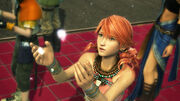
Vanille puzzled by crystalline souls.
Crystals represent life. People's souls can appear as crystalline specks, and l'Cie in crystal stasis—as well as those who go on to turn into Cie'th—have their souls trapped on the mortal realm by crystallizing the body (some refer to this as gaining an eternal life). In Final Fantasy XIII the crystals (known as eidoliths) that turn a regular human into a l'Cie are implied to originate from the gods. When Lightning and her companions enter the domain of the gods to face Pulse, his tendrils appear to implant the crystal shards into their bodies. The fal'Cie, directly created by the gods—Pulse and Lindzei—are sentient immortal machines powered by a crystal core, presumed to likewise originate from the gods.
The gods of the Fabula Nova Crystallis series take on a role akin to the "Great Old Ones" from H.P. Lovecraft lore; unlike archetypal benevolent gods in religion, the gods and fal'Cie are largely indifferent to the actions of humans, instead carrying out their independent existences, using humans as instruments when necessary. In Final Fantasy XIII when the party reaches Gran Pulse, the local fal'Cie are disinterested in the first humans from Cocoon to set foot on the ground for hundreds of years. Pulse and Lindzei, opposed and loathed by the opposite's human worshipers, are similar, and show no compassion toward humans, sending almost every last one to their graves as l'Cie tasked in slaying increasingly monstrous creatures. The goddess Etro is seemingly the only deity who empathizes with humans.
L'Cie and fal'Cie, as well as Cie'th, wield magic, and it is implied this power is granted by the crystal. In Final Fantasy XIII l'Cie "channel" their spells from their eidolith. A l'Cie can forge a pact with an Eidolon, messengers of the goddess Etro, and summon them to the mortal realm via their eidolith. Serah Farron relinquishes a "crystal tear" to her fiancé Snow Villiers, and it is implied to act as an extension of her being, allowing her to see and hear those near the crystal tear even if her physical body is elsewhere.
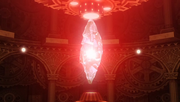
Vermilion Bird Crystal in Final Fantasy Type-0.
In Final Fantasy Type-0 the Crystals take a more traditional role as in early main series Final Fantasy games as entities that govern great magical power granted to the kingdoms of the world. The Crystals of Orience are sentient and make humans l'Cie to exert their Will in the world, even if Pulse and Lindzei also exist in the mythos, but one's soul can again be bound on the mortal realm via crystallization of the body. The Eidolons have a different form in Final Fantasy Type-0 than in Final Fantasy XIII, not being mechanical beings, but they are again implied to be of divine origin.
Glimmering floating intangible crystal shards that represent human souls appear in the Fabula Nova Crystallis games. They appear near the end of Final Fantasy XIII and in its sequels, and in the background of menus—such as the save screen—in Final Fantasy Type-0. Despite its connection to the Fabula Nova Crystallis series becoming tenuous, elements still appear in Final Fantasy XV. A particular remnant is the association of souls with floating transparent crystal shards: the crystal specks mainly appear when Noctis uses the powers of his ancestors via the bonding of the souls. The shards also appear during select story scenes tied to the mythos within each game.
Roles of humans
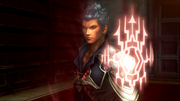
The Vermilion Bird l'Cie Zhuyu Voghfau Byot.
Humans in the Fabula Nova Crystallis mythos are unique creatures without parallel: they were created from material in the physical world (the blood of Etro), but hold the energy of the unseen realm (the chaos forming their hearts) inside them, giving them emotions and an independent self. This allows them to exist in both the physical and the ethereal. Other creatures, such as the world's deities and fal'Cie, are tied to the physical realm, and Etro was tied to the unseen realm after her death. The power humans hold is generally exploited by the fal'Cie by branding select humans as l'Cie.
The concept of l'Cie alludes to the Warriors of Light, a recurring theme in the Final Fantasy series where a group of warriors brought together by circumstance become "branded" the Warriors of Light by the crystal, giving them a mission to save the world and often special powers to achieve said mission. This is part of a larger concept of Fabula Nova Crystallis: Final Fantasy in re-imagining core concepts of the series. In previous games becoming a Warrior of Light was depicted as heroic, whereas the Fabula Nova Crystallis series explores the concept of servitude to the crystal in a more sinister light, bringing the free will of chosen "warriors" into question. Final Fantasy XV and its downloadable content likewise share the theme of questioning the free will of the "Warriors of Light"; ranging from Noctis' role as the True King, to the burden of the Kingsglaive and the fall of Ardyn Izunia. In all cases, the will of the world's deities and its Crystal appear in contrast with human wishes despite being for their ultimate benefit.
Human souls and their journey to the gate to the afterlife, known as Etro's gate, plays a role in all of the Fabula Nova Crystallis games, as do the recurring deities Pulse, Lindzei and Etro. This alludes to the original mythos where the creator god Bhunivelze wishes to find a way to enter the realm of the dead without needing to die himself, and creates the three lesser deities to help with the task. In Final Fantasy XIII and Type series, the deities have tasked their followers to find the gate in varying ways, but the humans of the world are largely ignorant of the concept of the afterlife.
Individual games
Final Fantasy XIII
- Orphan indirectly refers to the series title with the line, "From shattered shards, a new crystal legend will arise".
- The thirteenth Analect is called "Fabula Nova Crystallis". The analects themselves reprise the story from the official mythology adapted for the world of Final Fantasy XIII, and thus include the creation of Cocoon. Arks are armories created by Pulse fal'Cie, for "a battle in the beyond", referring to the battle Bhunivelze plans to wage against Mwynn after the Door of Souls is found.
- There is a piece of music on the fourth disc of the Final Fantasy XIII: Original Soundtrack called "Fabula Nova Crystallis".
Final Fantasy XIII-2
- The fragments Etro's Sorrow, Pulse's Resolution, Lindzei's Desire, Mwynn's Tenderness and Bhunivelze's Sleep allude to the official mythos where Etro suffered abandonment, Pulse was determined to find the gate to the afterlife, Lindzei wanted to protect the world, Mwynn was kind and compassionate, and Bhunivelze fell into a deep crystal sleep to be awaken when the Door of Souls would be found.
- Chaos, the malevolent substance that is also the building block for human hearts, was not mentioned in Final Fantasy XIII, but plays a crucial role in Final Fantasy XIII-2. The idea alludes to the official mythos where chaos is the substance threatening world balance.
- The concept of reincarnation is introduced in the form of Yeul and Valhalla. In the official mythos all souls form part of a cycle of reincarnation. In Final Fantasy XIII-2, souls pass through Valhalla to the unseen realm where they sink into the chaos until retrieved and placed inside new bodies while their hearts return to the chaos. Yeul's soul holds on to its identity and is unable to rejoin the cycle, so Etro grants it a constant rebirth in the same form: her various selves persisting in the unseen realm causes a critical imbalance in the levels of chaos that spells the end of the world.
- In the official mythos goddess Etro crafts people's hearts by placing a shard of chaos inside every newborn. In Final Fantasy XIII-2 Caius Ballad has the "Heart of Chaos", said to be Etro's own physical heart, given to him by her.
- Hope named the New Cocoon "Bhunivelze" after the deity who created Pulse, Lindzei and Etro in the official mythos.
Lightning Returns: Final Fantasy XIII
- The original mythos is reprised in the form of murals in the Temple Ruins. It focuses on Bhunivelze and his view on death as an impurity that ought not to exist. Bhunivelze himself hails from the official Fabula Nova Crystallis: Final Fantasy mythos. His turning into a crystal in the end alludes to the official mythos where Bhunivelze fell into a deep crystal sleep until he would be ready to challenge Mwynn in the unseen realm. Like in the official mythos, Bhunivelze desires to be the all-powerful ruler of the universe.
- Bhunivelze wanting to make Lightning the new goddess of death to facilitate the cycle of life may allude to Mwynn giving Etro a similar task in the official mythos.
- There is a student in Ruffian who studies "crystal legends", alluding to the term Fabula Nova Crystallis.
- The Temple of Light's Altars have long corridors with views to different areas from the trilogy, same as how Pandæmonium from Final Fantasy Type-0 has four long corridors with "windows" that look out to abstract areas from the game's past under attack.
Final Fantasy Type-0

Altocrystarium.
- All deities, except for Bhunivelze, have an accessory named after them. Pulse, Lindzei and Etro appear as part of the game's lore, although they are barely mentioned.
- When Class Zero is heading to the top of Pandæmonium, Cid mentions that mankind was born from Etro's blood, alluding to the original mythos.
- There are numerous references to Etro's gate:
- Ace's cards have a symbol similar to the gate on them.
- Cubes sport a symbol similar to the gate.
- Relic terminals sport a symbol similar to the gate.
- The cover of Rubicus bears a depiction of the gate.
- The front of the Altocrystarium sports a symbol similar to the gate due to its relationship to souls, or phantoma.
- When Dr Arecia summons Bahamut ZERO, the portal he emerges from is in the image of an eye.
- Above the Pandæmonium there is a large fiery sphere around which cogs turn and a mechanism with likeness to Etro's gate.
- Certain trap floors in Pandaemonium that deal damage when stepped on bear the likeness of Etro's gate.
- The design of the Rursan Arbiter sports many eye-like structures upon it.
- The peace treaty proposed during the cadets' Operation MA Demolition is called the "Fabula Pact."
- Ignis, an Ifrit Class Eidolon, is a name also seen in the other Fabula Nova Crystallis titles. Ignis is an ability name for Bahamut in Final Fantasy XIII and Chaos Bahamut in Final Fantasy XIII-2, and is a name for a character in Final Fantasy XV.
Final Fantasy XV
Although its link to the Fabula Nova Crystallis has been reduced to a low-key thematic one around which original lore is based,[1][2][3] Final Fantasy XV started its journey as Final Fantasy Versus XIII, counterpart to Final Fantasy XIII and part of the series where the games would share the same crystal lore. When the game was reworked into Final Fantasy XV the developers strove to keep as many elements of the original as possible, and thus Final Fantasy XV shares some of the same elements.
- A shared theme, as stated by Director Hajime Tabata in the Final Fantasy XV Ultimania -Scenario Side-, is the struggles of humans chosen for a task by the divine crystal.[4]
- In Final Fantasy XV: Episode Ardyn, defying fate is depicted as futile, with Ardyn's final choice being to either submit to his fate or resist it and face the wrath of the gods.
- The novel Final Fantasy XV -The Dawn of the Future- contains a path where the main characters find a way to defy their fate and find a solution that preserves lives.[5] In this alternate ending to the saga, Bahamut takes on a role akin to the deities in the Fabula Nova Crystallis series as a god who turns again man when the latter defies his plan for the world's "salvation." In the end, gods, magic and the Crystal vanish from the world and the people are left to carry on by their own devices, like the endings of Lightning Returns and Type-0.
- The royal families of Lucis and Tenebrae are given magical powers by the world's deities and their associated Crystal, a recurring theme in the Fabula Nova Crystallis games.
- Due to their nature, history and temperaments concerning humanity, the Astrals and their lore are similar to lore of the the gods and the fal'Cie of Fabula Nova Crystallis: Final Fantasy.
- In Final Fantasy Versus XIII Etro was the goddess of death who opened "the door" to the afterlife. Though this concept was not used in the game, it appears that the goddess in the game's logo
 , and in the painting of the prophecy
, and in the painting of the prophecy , have been inspired by Etro and Yoshitaka Amano's logo artwork.[1] The logo is eventually shown to represent Lunafreya's sleeping spirit, while the winged figure in the painting represents the divinely-gifted Oracle.
, have been inspired by Etro and Yoshitaka Amano's logo artwork.[1] The logo is eventually shown to represent Lunafreya's sleeping spirit, while the winged figure in the painting represents the divinely-gifted Oracle.
- In Final Fantasy XV, the Crystal itself acts as the door to a heavenly realm, somewhat akin to the role of Etro's gate in the Fabula Nova Crystallis series.
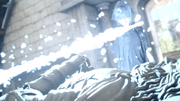
Noctis collects a Royal Arm.
- Crystalline fragments representing the power and presence of souls appear when Noctis is retrieving a royal arm from a royal tomb. According to Cor Leonis, the weapons are bequathed through the "bonding of souls". The soul crystals also appear when Noctis is about to summon, and when he wields the Ring of the Lucii in battle. During the ending, soul fragments appear at Noctis and Lunafreya's wedding.
- Noctis's ten-year slumber inside the Crystal of Lucis is similar to crystal stasis as seen in other Fabula Nova Crystallis games, although he ages during his slumber.
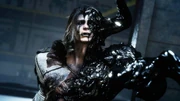
A recently turned daemon.
- The corruption which turns humans into daemons in the world of Eos is similar to both the power of chaos and the Cie'th curse in the Fabula Nova Crystallis mythology.
- Additionally, the Japanese word for "daemons", (シガイ, Shigai?), is pronounced identically to the Japanese names for Cie'th.
- Ardyn Izunia's condition as a cursed being rejected by the Crystal also recalls the concept of the Cie'th.
- References are made by the Astral Bahamut to the concept of "Providence", a term used in Final Fantasy XIII to represent the will of Etro in the Analects.
- The lyrics of "Somnus" and "Omnis Lacrima" refer to a sleeping god waiting for the call to awaken, and that his awakening will be heralded by turmoil. These references parallel the lore surrounding Bhunivelze. In the context of Final Fantasy XV, the lyrics could allude to the Astrals that had been sleeping for eons before being roused by Lunafreya, heralding a time of turmoil for those near them and for Eos as a whole.
- In the "Final Fantasy XV Universe E3 2017 Trailer", at 2:23, when the various aspects of the Final Fantasy XV narrative are highlighted, an eye-shaped design appears. Within the Fabula Nova Crystallis mythos, Etro's gate has repeatedly been represented as an eye-like shape, or has been related to eyes.
References
- ↑ 1.0 1.1 16 More Things We Learned About Final Fantasy 15 (Accessed: August 30, 2015) at Gamespot
- ↑ 『ファイナルファンタジーXV』発売時期を示唆、『Just Cause 3』との技術協力も決定【gamescom 2015】 QUOTE:
――ではもうひとつ。神話や神についての設定は、『FFヴェルサスXIII』から『FFXV』への移行により変更があるのでしょうか。
田畑: 『FFXV』にする段階で、そこまでに固まっていた設定については、神話とは強く絡めず『FFXV』の設定として取り込んでいます。ファブラの神話として出てくるものではありませんが、ベースとして活きています。 - ↑ http://www.finaland.com/?rub=site&page=news&id=5516
- ↑ (2016-12-28) Final Fantasy XV Ultimania -Scenario Side- (in Japanese). Tokyo: Studio Bentstuff.Invalid citation format.
- ↑ 小説 FINAL FANTASY XV -The Dawn Of The Future- (Accessed: February 20, 2019) at Square Enix Store Japan

